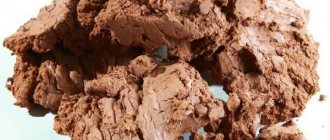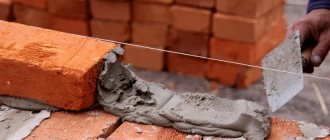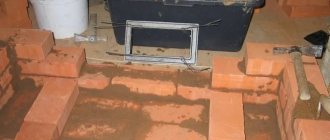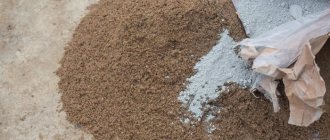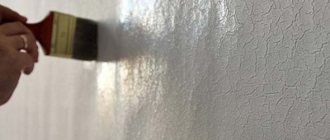The mortar for laying cinder blocks must be of high quality.
After all, the strength of the constructed object depends on it. A weak connection between the elements will lead to the structure quickly collapsing. Read the article about what kind of solution to place the cinder block on and what should be included in this installation mixture, as well as what the requirements are for it and how to prepare it correctly.
What mixtures are used for installation?
The solution is necessary for reliable fastening of building elements to each other. It comes in two types :
- Dry purchased mixture . It is ready to use. The only thing you need to do is add the amount of water indicated in the instructions. The advantage of this composition is that it is easy and convenient to use. Plasticizers have already been added to it, giving it strength. However, it will cost more than homemade compounds. Considering the scale of construction, the amount can be impressive.
- Homemade solution . It is based on several components, the cost of which is low, so the use of such a composition allows you to significantly save your budget. The main disadvantage is the need for strict adherence to proportions. Their violation will negatively affect the properties of the mixture.
Advice! The thickness of the solution layer should be the same for both homemade and ready-made purchased compositions. Its increase does not contribute to increasing the strength of the structure.
Necessary components for preparation
The classic mortar for laying cinder blocks consists of three components:
Sand .
It must be clean, without foreign impurities that will lead to the formation of lumps. Sand must be purchased at the store. You can make a choice in favor of class II river or quarry sand, or a mixture of both. The grains of sand in it are small, so the adhesion to the surface will be strong.- Cement . The choice should be made in favor of Portland cement, which is a hydraulic binder based on gypsum, cement clinker and additives. Its brand must be no lower than M400 or M500.
- Water . It must be clean, without silt or mold, which can impair the quality of the adhesion of the solution and provoke the destruction of the structure. There should be no excess or deficiency of minerals in the water.
Composition requirements
The mortar for laying cinder blocks must meet the following requirements:
- Spreadability , which allows it to be evenly distributed over the surface.
- Viscosity , due to which it does not flow from the building material.
- Strength after drying, on which the reliability of the erected structure depends.
- Consistency . It should not be too thick and not too runny. By analogy, it can be compared with sour cream.
- Lack of lumps , which is necessary for uniform laying of blocks.
A solution that meets these requirements guarantees the strength of walls and partitions.
Recipe with sand and cement
You can prepare the mortar for laying cinder blocks with your own hands, or use dry store-bought mixtures. Regardless of the chosen solution to the problem, it is necessary to adhere to certain proportions.
How to make it from scratch with your own hands?
To prepare the mixture yourself , follow the following proportions and recommendations :
- Take 1 part cement to 3 parts sand.
- To determine the proportions, use the same container, that is, one bucket or basin.
- When preparing the mixture, you need to take into account the size of the concrete mixer and correlate it with the volume of the measuring container, since it will be impossible to remove or add components to it.
- If you plan to add red clay to the mixture, then take it in the amount of 1/3 of the above proportions.
- Water is introduced gradually, only after the concrete mixer is put into operation. Its quantity depends on the type of masonry. Ultimately, you should get a solution with a consistency reminiscent of sour cream.
Important! Water is poured into one bucket at a time. If you fill the entire volume at once, the solution may turn out to be too liquid. As a result, it will not be possible to use it for masonry, as it will spread.
From ready-made dry materials
Ready-made dry mixtures do not require complex calculations . They already contain all the necessary components; the builder will only have to add water. Such solutions are universal; they can be used for dense masonry and for masonry in a thin layer, but the minimum layer thickness should be 3 mm.
Solutions based on ready-made dry mixtures are used not only for masonry, but also for repairing chips and other damage.
Depending on the brand of the mixture chosen, the amount of water may vary. The manufacturer's instructions will help you determine the exact proportions. Universal recipe for preparing masonry composition :
- The finished dry mixture is poured into a container with clean water at the rate of 0.21 - 0.23 liters per 1 kg of powder.
- Stir for 5 minutes until a plastic mass is obtained.
- Leave the mixture for 2 minutes and mix again.
- Start laying.
Lime must not be added to the finished mixture . This will cause the solution to become less durable after hardening. Red clay and plasticizers are used as components that increase the adhesiveness and density of cement.
How to make sand concrete blocks - step by step
Mix the solution according to one of the recipes. Lubricate the inside of the mold with oil or other lubricant. We spread a piece of film on a vibrating table or lay it on a flat surface (check with a level, otherwise the geometry of the blocks can be very bad). If you are planning blocks with voids, insert, for example, pipe sections into the filled form. And then the process of vibrating the table starts. Or the blocks simply freeze to such a state that they can be removed from their molds without being damaged. This usually takes 1-2 days. But in any case, hardening and drying of sand concrete blocks should not be done in the sun. It is even advisable to dry them indoors (in a barn, for example) for 10 days.
After this, the products can be placed under a canopy for final drying.
Calculation of consumption per cubic meter
When calculating the required amount of material, you need to build on the type of masonry.
The most common and economically advantageous is masonry of 0.5 - 1 block. In this case, the thickness of the layer will be 1-2 cm. It is no longer recommended to do it, as this will negatively affect the strength of the object being built.
Recommendations for performing calculations:
- Decide on the amount of material needed.
- Calculate the cost of masonry taking into account the thickness of the layer.
- You should not buy material for future use. Store-bought mixtures or consumables for making it yourself are always available for sale.
If you cannot cope with the calculations yourself, you need to contact specialists.
Here is an example of how much mortar needs to be prepared per cube of cinder block masonry: with a wall thickness of 40 to 50 cm and when performing work at a temperature of +5...+25 degrees, the minimum consumption of the mortar is 30-40 kg per 1 m3.
Inappropriate size
The standard size of a sand block is 20 cm wide, 20 cm high and 40 cm long. You can measure with an ordinary tape measure or ruler. However, the manufacturer can produce sand blocks of a smaller size, demanding a full amount for this.
Inexperienced people cannot notice this flaw simply by eye, so it is important to check the size. A smaller size is unlikely to affect the strength and quality of construction, but it will be a shame for the fact that you will pay more money for a smaller size.
Colored sand blocks
What other mixtures can be used?
To prepare the solution, you can use different types of mixtures, including :
- Composition for masonry M25. It is based on M300 cement with the addition of one part of sand.
- The M75 solution is based on the M400 solution with the addition of lime (0.5 parts) and sand (4 parts).
- Mixture M100. It is based on M400 cement, 0/3 parts lime and 4 parts sand.
- Mortar M150 based on cement with 2.5 parts sand and 0.1 parts lime.
Adhesive for cinder blocks
Adhesive for cinder blocks is often used instead of classic masonry mortars. It has a number of advantages :
- Increases the strength and durability of an object.
- Economically consumed per 1m3.
- Allows you to achieve good adhesion of blocks, which is possible due to the presence of fractional sand in the composition.
Glue is more expensive than conventional solutions, so it is advisable to use it in cases where the surface of the blocks is not porous and has ideal smoothness.
Another option is to carry out work in winter. The use of glue allows for better hardening of the seams.
Popular brands of adhesive for cinder block:
- Bergauf Kleben Block. Frost-resistant adhesive for cellular blocks.
- Normada.
- Ceresit ST 21. Adhesive for laying cellular concrete blocks.
What is needed to make sand cement blocks
Forms - you can make them yourself, preferably detachable ones (from boards, plywood, plastic, etc.); oil for lubricating molds (the easiest way is to use machine oil); polyethylene film or plastic ; a vibrating table when making sand cement blocks . Purchased vibrating tables are expensive; you should buy such a device only if you are going to set up your own business. But a basic vibrating table is easy to make; there are diagrams and detailed descriptions online. In extreme cases, if there is a need for sand concrete blocks for a small building or fence, you can do without a vibrating table - in this case, you will need to pay more attention to the high-quality filling of the forms, that is, when filling them, the solution will need to be compacted well, slowly.
Average prices
The price of compositions for laying cinder blocks depends on the manufacturer and the markup set by the retail outlet.
Average cost of products in the Russian Federation :
- Glue – 350 rubles for 25 kg.
- Ready-made mixtures – 200 rubles per 25 kg.
- Cement M500 (for preparing the solution yourself) – 300 rubles per 50 kg.
So, glue is more expensive than other compounds . The price for ready-made dry mixtures is slightly lower, and the most budget-friendly option is to prepare the solution yourself.
Composition by type of filler
Cinder block is produced in the form of a solid or hollow parallelepiped with right angles. The following compositions of building stone are distinguished depending on the filler:
- SCC - with the addition of cement as a binder.
- SKI - with the addition of lime as a binder.
- SKSH - with the addition of slags of various origins.
- SKG - with the addition of gypsum or alabaster.
The cinder block is divided by size into whole (number 1 in the marking), longitudinal half (number 2) and partition wall block (number 3).
For example, SKTs-1 (cement wall stone), SKI-3 (lime wall stone), SKSH-1 (slag wall stone), SKG-2 (gypsum wall stone), etc. Table
| Block type | Options | Compressive strength grade | Size, cm | Cinder block weight (kg), solution density 800–2200 kg/m3 | Volume of concrete, m3 |
| SKTS-1; SKI-1; SKSH-1 | Solid ordinary block | M25, M35, M50 | 39×19×18,8 | 8,4–31 | 1,05–1,4 |
| SKTS-2; SKI-2; SKSH-2 | Longitudinal half | M75, M100, M125, M150, M200 | 39×9×18,8 | 4,4–15 | 0,55–0,6 |
| SKTS-3; SKI-3; SKSH-3 | Cloisonne block | M25, M35, M50 | 59×9×18,8 | 6–22 | 0,7–1 |
| SKG-1 | Solid ordinary block | M25, M35, M50 | 39×19×18,8 | 16,6–23 | 1,4 |
| SKG-1A | Solid ordinary block | M25, M35, M50 | 41×21,5×19 | 20,1–27,5 | 1,68 |
| SKG-2 | Longitudinal half | M75 | 39×9×18,8 | 8–11 | 0,6 |
- Depending on the filler introduced, a solid block has an average weight of 25-28 kg, a hollow block - 18-23 kg, and a half-slag block - 10-13 kg. The thermal conductivity coefficient of a cinder block also depends on the composition of the solution and occupies the range of 0.27–0.65 W/m*K.
- The compressive density is allowed in the range of 750–1455 kg/m3. When the density changes, the thermal conductivity and strength of the wall stone changes. Also, the density characteristics, weight of the blocks and thermal conductivity depend on the composition of the mixture and the number of voids in the product - they can be oval, round, rectangular or square.
- The percentage of voids to filler is 28–40%.
- The texture of the blocks is divided into smooth (without visible surface defects), polished (1 grinding cycle), corrugated (repeating irregularities) and chipped (the surface is leveled by chipping off the protrusions). For different slag concrete fillers, their own, most optimal, stone texture is determined.
Table of composition of fillers for wall blocks
| Type of filler | Cement kg/m3 | Brand/class of concrete | Density kg/m3 |
| Blast furnace, coal, wood, open hearth ash and sand | 120–160 | 75/5 | 1800 |
| Fly and waste ash | 100–150 | 50/3,5 | 1550 |
| All types of ash and sawdust (shavings) | 220–290 | 35/2,5 | 950 |
| All types of ash and expanded clay | 120–160 | 75/5 | 1300 |
| Quartz sand and expanded clay | 170–200 | 75/– | 1400 |
| Quartz sand and sawdust (shavings) | 300–340 | 50/3,5 | 1200 |
| Quartz sand and polystyrene foam | 320–400 | 35/2,5 | 800 |
| All types of ash polystyrene foam | 300–380 | 35/2,5 | 750 |
| Quartz sand and crushed brick | 100–150 | 75/5 | 1900 |
| Slag and all types of ash | 120–180 | 75/5 | 1800 |
| Arbolit | 280–320 | 25/2 | 700 |
| Soil concrete | 220–300 | 15/1 | 1900 |

